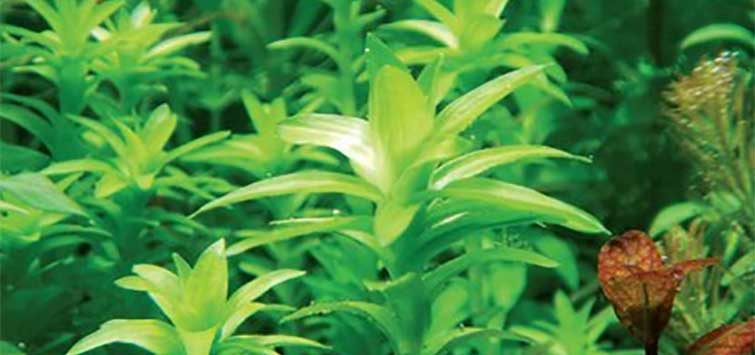Ludwigia x lacustris
Author: Cavan Allen
Common Names: Lake Ludwigia
Division: Magnoliophyta
Class: Magnoliopsida
Order: Myrtales
Family: Onagraceae
Native Distribution: Rhode Island to Georgia Aquarium
Aquarium Placement: Background
Requirements: Medium to high light, ample iron, CO2 injection
Plant Description
Ludwigia x lacustris is an aquatic herb that was introduced relatively recently to the aquarium hobby. A very rare natural hybrid of L. brevipes and L. palustris, it is found as roughly a dozen widely scattered populations in coastal areas from Rhode Island to Georgia. Curiously, it occurs in several places within the broad range of L. palustris but well outside the rather restricted range of L. brevipes, which occurs mainly in southeastern Virginia and North and South Carolina. The reasons for this are unclear, but it may be because L. brevipeshad a much wider distribution in the recent past. Alternatively, it may have been transported to new locations by waterfowl or some other means.
Where it does occur, it often grows vigorously enough to virtually exclude its parents, a trait commonly shared by many other hybrids. Lake ludwigia is often equally distributed in abundance above and below the water—growing as far down as several feet—and is rarely difficult to find. It was originally described by Eames in 1933 as Ludwigia lacustris, and its hybrid nature was only realized later.
Like one of its parents, L. brevipes, the innermost portions of its leaves are the palest, gradually changing from green to orange along the length of the leaf. Unlike L. brevipes, which usually grows as a sort of low hedge, it shares the more upright growth habit of its other parent species, L. palustris. But unlike the more established and faintly similar narrow leaf ludwigia Ludwigia arcuata x repens, another hybrid, it does not grow at a 45° angle. Leaf width and shape are intermediate between both of its parents, and in good conditions the leaves become roughly diamond shaped.
Aquascaping Uses
Undoubtedly, Ludwigia x lacustris is best used as a background plant (or perhaps in the middle area of a very large aquarium). Robust groupings show lake ludwigia to best effect; like closely related Ludwigia species, it does not look quite as good as only a few stems. Its growth can be very vigorous indeed, but fortunately it does not appear to suffer from regular pruning. It contrasts particularly well with tall hairgrass Eleocharis species and other plants with green color and a fine texture.
This plant is quite adaptable and forgiving, but when given strong light, CO2, and lots of iron, it takes on a brilliant rust color that is rarely rivaled. It will then achieve its maximum size of perhaps 3 inches from leaf tip to leaf tip.
Propagation
Propagation poses no problems whatsoever. New shoots are continually produced and yet, after trimming, even more tend to come out. If allowed to sprout from an aquarium or pond, lake ludwigia will grow attractive flowers with yellow petals (in contrast to the drab flowers of L. palustris, which lack petals entirely). If any of the flowers should become pollinated, fertile seeds are unlikely to result, which is perhaps why this wonderful plant is not more widespread. Hybrids often are sterile, so it’s very fortunate that this is one that is so easy to propagate vegetatively.

.png?h=595&iar=0&w=2781&hash=5FD5E69473BCC22199FBFA2FB71B6033)



